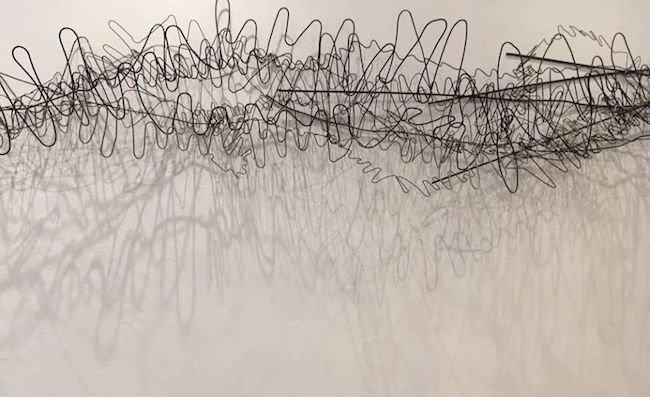Alcuni creativi hanno bisogno di partire da sé per andare a rappresentare una realtà circostante che proprio in virtù di un’osservazione attenta e approfondita ma soprattutto espressione di sensazioni a volte persino confuse e inconsapevoli, diviene concreta e universale; la sensibilità degli artisti induce infatti l’essere umano, inteso come fruitore, a porsi in posizione più aperta, più empatica, oppure ad accogliere un punto di vista anche contrapposto al proprio ma ugualmente forte e considerevole. L’interazione tra soggettività dell’esecutore di un’opera e stimolo di approfondimento sollecitato nell’osservatore, genera quella tendenza alla concettualizzazione che induce a comprendere semplicemente in virtù di un istinto, di un’intuizione che si amplifica fino a espandersi verso contenuti globali. La protagonista di oggi è una perfetta interprete di questo tipo di approccio artistico poiché partendo da un forte legame con la consapevolezza del proprio processo meditativo, genera opere dalle quali l’osservatore viene letteralmente magnetizzato, avvolto dalla loro legerezza che però sottintende un’intensa profondità.
Il percorso di distacco e di affrancamento dal legame formale con l’immagine visibile, con la riproduzione fedele della realtà osservata, iniziato fin dal principio del Ventesimo secolo e proseguito estremizzando in maniera sempre più netta la necessità di stravolgere le linee guida dell’arte accademica fino a poco prima predominante, quel percorso, dicevo, sfociò intorno agli anni Sessanta del Novecento in un nuovo stile che raccolse tutte le eredità dei precedenti movimenti dei primi ventenni trasformandole in basi necessarie a lasciar emergere il concetto più che la sua forma estetica. Già il Dadaismo aveva avuto un atteggiamento dissacrante nei confronti dell’arte precedente, trasformando ironicamente in opera qualsiasi oggetto quotidiano per porre l’accento su quanto spesso la manifestazione espressiva avesse un valore puramente venale governato dalle leggi del mercato; l’Informale invece, a cui appartiene il Minimalismo forse massima esaltazione della purezza e della rigorosità della creazione artistica, indusse a perdere il contatto con ogni riferimerimento alla realtà aprendo nel contempo la strada all’utilizzo di vari materiali che potessero interagire con il colore, o con il non colore, e che potessero entrare a far parte di un’opera. Negli anni Sessanta del Ventesimo secolo tutte queste fondamenta furono utilizzate dagli appartenenti all’Arte Povera e all’Arte Concettuale, per uscire dalla bidimensionalità dell’opera, come d’altronde fecero i dadaisti dei quali abbandonarono però l’atteggiamento derisorio per entrare nel mondo della riflessione, della connessione tra pensiero e oggetto, per scoprire la correlazione tra rappresentazione del pensiero e collocazione nello spazio. Iannis Kounellis fu uno dei maggiori interpreti dell’Arte Povera ma anche dell’Arte Concettuale poiché sebbene le due manifestazioni artistiche si distinguano dal punto di vista dell’utilizzo dei materiali, di fatto entrambe confluiscono sul legame tra visibile e significante. La scultura si trasforma così in installazione, aumenta la dimensione delle sue forme, interagisce con lo spazio circostante come se esso fosse parte della realizzazione finale, e di questo approccio è celeberrimo rappresentante Anish Kapoor, fino addirittura a uscire dalle abituali situazioni espositive per spostarsi all’esterno come nella Land Art di Christo o di Richard Long.
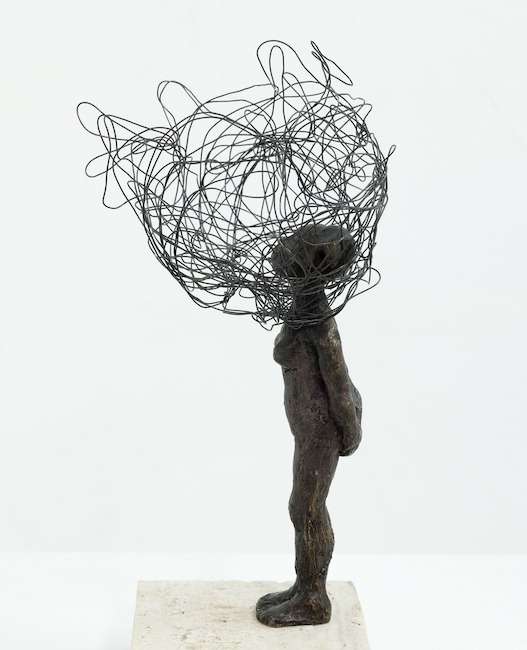
L’artista giapponese Mariko Kumon, ha scoperto la sua strada artistica in occasione del suo trasferimento a Barcellona, città dove vive e opera ormai da molti anni, smettendo di lavorare per la sua famiglia dove utilizzava la matematica applicata che era stata materia di laurea nel suo paese natale, e aprendosi al possibilismo, all’approfondimento di un’interiorità che ha bisogno dell’arte per riuscire a emergere e a raggiungere la coscienza; il cambiamento è stato radicale quanto necessario per esprimere una personalità creativa che non poteva più essere trattenuta, e che ha scelto di liberarsi dalla gabbia della ragione e della logica, ma soprattutto dalla convinzione comune secondo cui consacrare la vita all’arte può generare maggiori difficoltà che non orientarsi vero una professione più pratica e convenzionale. Ed è proprio da questo coraggio, da questa capacità di sfuggire alle regole, che nasce la sua arte, sicuramente Concettuale, ma anche manifestazione profonda di un sé che di volta in volta trova il modo di esprimere un pensiero, una sensazione, una riflessione su ciò che sente vibrare intorno; il suo equilibrio tra emozione e ragione si svela dalle forme non forme attraverso le quali genera le sculture, installazioni che sembrano essere rappresentazione di lievi percorsi mentali consolidati esattamente in virtù di quel loro essere impalpabili, di quella delicatezza che però fuoriesce in tutta la sua concretezza, nella solidità del flusso di pensieri che ne derivano e che vanno a spingersi verso la consapevolezza.

La produzione artistica di Mariko Kumon è contraddistinta da espressioni formali differenti eppure tutte legate da un denominatore comune, quello della continuità, di un reiterarsi e allungarsi nello spazio che infonde nell’osservatore la sensazione dello sviluppo, della consequenzialità e dell’interconnettività tra istanti differenti, distaccati ma uniti dalla sensazione soggettiva.
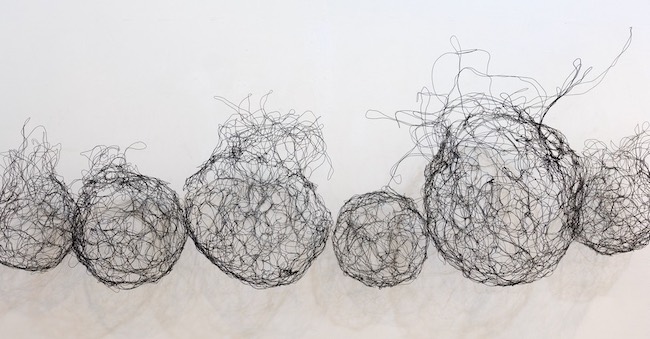
I fili costituiscono dunque le idee, quei frammenti di pensieri che si susseguono in maniera spesso confusa e che hanno bisogno di essere ascoltati, di essere osservati uno a uno per dar corpo al concetto generale che va a generarsi; a questa linea produttiva appartiene l’opera Nadie puede encerrarme, dove i gomitoli di filo nero rappresentano la personalità di ciascun individuo che tende a proteggersi dalle ingerenze esterne poiché malgrado le insicurezze e l’instabilità interiore, ciò a cui ciascuno anela è di essere accettato nella sua interezza. La riflessione di Mariko Kumon parte dunque da se stessa, che si è liberata da un abito che non le apparteneva, quello della rinuncia alla sua vera natura artistica, e si estende all’attitudine contemporanea a una modificazione compiuta dall’uomo per adeguarsi alle richieste dell’ambiente esterno ma che di fatto lo induce a dimenticare il suo vero io che ha bisogno invece di fuoriuscire. L’apertura di un lato delle sfere descrive esattamente il momento in cui l’interiorità rompe gli argini e sceglie di far sentire in modo chiaro la propria voce. Lo spazio circostante all’installazione ha dunque il compito di accogliere quella liberazione e rendere possibile la creazione di una realtà diversa e più affine.

La serie denominata Skin invece assume formalmente una maggiore concretezza, è costituita da pelle e alghe e si sofferma sul concetto dell’irregolarità, dell’imperfezione che appare costantemente nella natura generando la bellezza esattamente da quella base di mancanza di regolarità che diviene unicità, che non permette l’uniformazione, sfugge alla generalizzazione proprio in virtù dei corrugamenti, delle pieghe, raccontate dalle sfere di pelle, che vanno a costituire infinite sfaccettature.
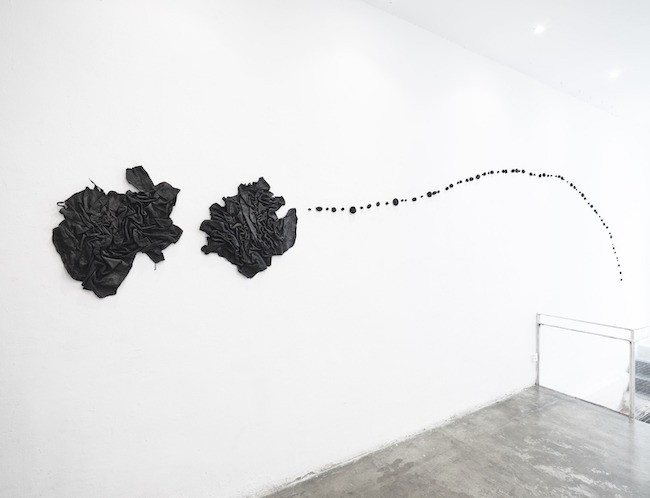
La disuguaglianza, le differenze, sono spesso causa di conflitti, di diffidenze dovute alla mancanza di similitudine eppure, sembra suggerire Mariko Kumon, è esattamente dalla singolarità che si genera la ricchezza dell’universo, umano come naturale, perché è dall’opposizione tra differenze che tutto può tendere verso una costante evoluzione; questo concetto è perfettamente evidente da quel susseguirsi di sfere irregolari che vanno a costituire il percorso di progresso, inteso come accrescimento spirituale.
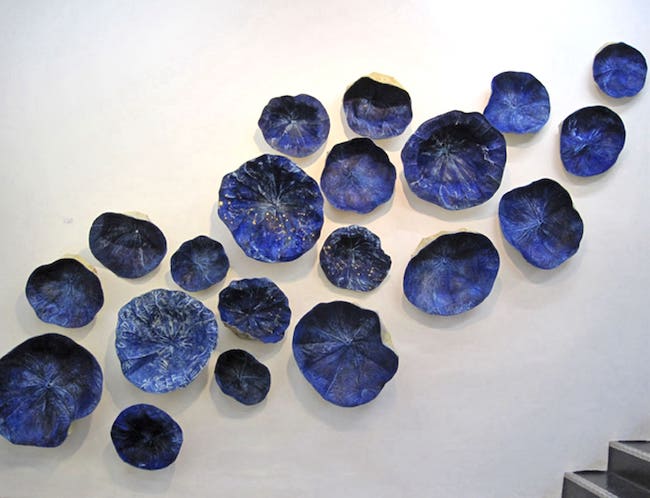
La terza serie produttiva di Mariko Kumon è quella che tende verso il colore, pur manifestato attraverso differenti forme, a volte più legate allo scrigno emotivo dei ricordi dell’artista, altre invece più basato sul concetto universale dell’unione di variegate intenzioni, dell’armonizzazione che non può che generare un’eco di accettazione e di vicinanza in grado di accrescere quel senso di unione, di pace che troppo spesso viene rotta proprio dall’incapacità degli individui di restare l’uno accanto all’altro.

Nell’opera Transicion infatti, contraddistinta dal vivace colore rosso associato al coraggio e alla determinazione, Mariko Kumon divide la composizione in tre differenti moduli, tutti costituiti da piccole celle ottagonali, l’ottagono è associato all’universo, che inizialmente tendono a restare staccate le une dalle altre e a liberarsi fluttuando ciascuna nel suo piccolo mondo fatto di individualità, poi cominciano a decidere di associarsi in maniera casuale e poi infine scelgono di rimanere insieme con la gioia e il desiderio di farlo, comprendendo quanto essere uniti sia molto meglio che essere divisi. Mariko Kumon ha un lungo percorso espositivo alle sue spalle, ha partecipato a mostre collettive in Italia, Usa, UK, Spagna, Giappone, Francia, Belgio, Brasile, Austria, Svizzera, Lussemburgo, e personali in Spagna e in Giappone, ha vinto molti premi artistici e le sue opere sono inserite in importanti cataloghi e riviste internazionali.
MARIKO KUMON-CONTATTI
Email: kumonmariko@gmail.com
Sito web: www.marikokumon.com/
Facebook: www.facebook.com/marikokumon4
Instagram: www.instagram.com/mariko_kumon/
Balance between thoughts and emotions in Mariko Kumon’s sculpture-installations, when the concept takes shape from a thin thread
Some creatives need to start from themselves in order to represent a surrounding reality that, precisely by virtue of careful and in-depth observation, but above all the expression of sometimes even confused and unconscious sensations, becomes concrete and universal; the artists’ sensitivity in fact induces the human being, understood as the observer, to place himself in a more open, more empathetic position, or to welcome a point of view that may be opposed to his own but is equally strong and considerable. The interaction between the subjectivity of the author of an artwork and the stimulus of deepening solicited in the observer, generates that tendency towards conceptualisation that induces understanding simply by virtue of an instinct, of an intuition that is amplified to the point of expanding towards global contents. Today’s protagonist is a perfect interpreter of this type of artistic approach since, starting from a strong link with the awareness of her own meditative process, she generates works from which the observer is literally magnetised, enveloped by their lightness that however implies an intense depth.
The path of detachment and liberation from the formal link with the visible image, with the faithful reproduction of observed reality, which had begun at the beginning of the Twentieth century and continued by taking the need to overturn the guidelines of academic art that had until then predominated to an ever more extreme degree, that path, as I was saying, led around the 1960s to a new style that took up all the inheritances of the previous movements of the early twenties and transformed them into the necessary foundations to let emerge the concept rather than its aesthetic form. Dadaism had already had a desecrating attitude towards previous art, ironically transforming any everyday object into a work of art to emphasise how expressive manifestation often had a purely venal value governed by the laws of the market; Informalism, on the other hand, to which belongs Minimalism perhaps the highest exaltation of the purity and rigorousness of artistic creation, induced the loss of contact with any reference to reality while opening the way to the use of various materials that could interact with colour, or non-colour, and become part of a work. In the 1960s, all of these foundations were used by the members of Arte Povera and Conceptual Art to break out of the two-dimensionality of the artwork, as did the Dadaists, whose derisive attitude they abandoned in order to enter the world of reflection, of the connection between thought and object, to discover the correlation between representation of thought and location in space.
Iannis Kounellis was one of the greatest interpreters of Arte Povera, but also of Conceptual Art, because although the two artistic manifestations differ in their use of materials, in fact both converge on the link between the visible and the signifier. Sculpture thus becomes an installation, increases the size of its forms, interacts with the surrounding space as if it were part of the final creation, and Anish Kapoor is a famous representative of this approach, even going beyond the usual exhibition situations to move outdoors as in the Land Art of Christo or Richard Long. The Japanese artist Mariko Kumon discovered her artistic path when she moved to Barcelona, city where she has worked for many years now, stopping working for her family where she used applied mathematics that had been the subject of her degree in her native country, and opening up to possibilism, to the deepening of an interiority that needs art to be able to emerge and reach consciousness; the change was as radical as it was necessary in order to express a creative personality that could no longer be held back, and that chose to break free from the cage of reason and logic, but above all from the common conviction that devoting one’s life to art can generate greater difficulties than turning towards a more practical and conventional profession.
And it is precisely from this courage, from this ability to escape the rules, that is born her art, certainly Conceptual, but also a profound manifestation of a self that from time to time finds a way to express a thought, a sensation, a reflection on what feels vibrating around; her balance between emotion and reason is revealed by the non-forms through which she generates her sculptures, installations that seem to be representations of slight mental journeys consolidated precisely by virtue of their being impalpable, of that delicacy that nevertheless emerges in all its concreteness, in the solidity of the flow of thoughts that derive from them and that move towards awareness. Mariko Kumon‘s artistic production is characterised by different formal expressions and yet all linked by a common denominator, that of continuity, of a reiteration and elongation in space that instils in the observer the sensation of development, of consequentiality and interconnectivity between different instants, detached but united by subjective sensation. The threads therefore constitute the ideas, those fragments of thoughts that follow one another in an often confused manner and that need to be listened to, to be observed one by one in order to give substance to the general concept that is being generated; the artwork Nadie puede encerrarme belongs to this line of production, where the balls of black thread represent the personality of each individual who tends to protect himself from external interference, because despite insecurities and inner instability, what each person yearns for is to be accepted in his or her entirety.
Mariko Kumon‘s reflection thus starts from herself, who has freed from a garment that did not belong to her, that of renouncing her true artistic nature, and extends to the contemporary attitude of a modification made by man in order to adapt to the demands of the external environment but which in fact causes him to forget his true self, which needs instead to come out. The opening of one side of the spheres describes exactly the moment when interiority breaks through the banks and chooses to make its voice heard. The space surrounding the installation thus has the task of accommodating that liberation and making possible the creation of a different, more relatable reality. The series called Skin, on the other hand, formally assumes a greater concreteness; it is made up of skin and seaweed and dwells on the concept of irregularity, of the imperfection that constantly appears in nature, generating beauty precisely from that basis of lack of regularity that becomes uniqueness, that does not allow for uniformity, that escapes generalisation precisely by virtue of the corrugations, of the folds, told by the spheres of skin, that go to constitute infinite facets. Inequality, differences, are often the cause of conflicts, of mistrust due to the lack of similarity, and yet, Mariko Kumon seems to suggest, it is precisely from singularity that is generated the richness of the universe, human as well as natural, because it is from the opposition between differences that everything can tend towards a constant evolution; this concept is perfectly evident from that succession of irregular spheres that constitute the path of progress, understood as spiritual growth.
Mariko Kumon‘s third productive series is the one that tends towards colour, although manifested through different forms, at times more linked to the emotional treasure chest of the artist’s memories, at others more based on the universal concept of the union of variegated intentions, of the harmonisation that cannot but generate an echo of acceptance and closeness capable of enhancing that sense of union, of peace that is all too often broken precisely by the inability of individuals to remain side by side. In the artwork Transicion, characterised by the bright red colour associated with courage and determination, Mariko Kumon divides the composition into three different modules, all made up of small octagonal cells – the octagon is associated with the universe – which initially tend to remain detached from each other and to free themselves, each floating in their own little world of individuality, then they start deciding to associate in a random way and then finally choose to stay together with the joy and desire to do so, realising how being united is much better than being divided. Mariko Kumon has a long exhibition history behind her, she has participated in group exhibitions in Italy, USA, UK, Spain, Japan, France, Belgium, Brazil, Austria, Switzerland, Luxembourg, and solo exhibitions in Spain and Japan, she has won many art awards and her works are included in important international catalogues and magazines.


